March 20,2015
When an acquaintance, Tom, emailed me and asked would I like to join him for a round at The Olympic Club, I had to catch my breath. Who wouldn't like a chance to experience Olympic? After thanking him for thinking of me, and working out a date, I waited the next few months with great anticipation.
I had a week-long work trip to Las Vegas in mid-March, and as luck would have it, the week after the trip is when Tom wanted to play Olympic. Tom lives in the frozen north, hadn't played golf in months, and wanted to get a few rounds in before the tee time at Olympic, so he came out to Vegas the same week I was there for business. He had cleared an evening in his schedule and I was able to offer a small thanks for his gracious invite to Olympic by taking him to dinner at Gordon Ramsey Steak Restaurant to celebrate his birthday. We chatted about the rounds he had played and would play while in Vegas (most notable was Shadow Creek), discussed my golf rounds the few days prior in Mesquite, and excitedly discussed our upcoming round at Olympic the following week. The wine was great, the steak was fantastic, and the conversation and company were second to none.
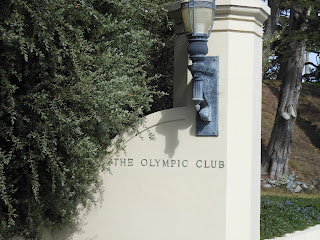 |
| Entrance gate to the Olympic Club. |
The day we played Olympic was an almost perfect weather day, with mid 70s and slightly overcast skies. I arrived early, was able to look around the clubhouse and pro shop, take a few photos of the grounds, and then Tom arrived. We warmed up at the range and putting green, and then met the member we would be playing with. The member was fantastic at giving us a brief history of the club, asking us what tees we were comfortable with, asking about our previous golf experiences, and making sure we were generally at ease as we approached the first tee box.
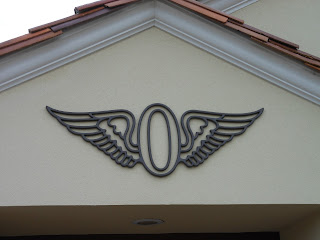 |
| The logo of Olympic Club above the entrance to the Pro Shop. |
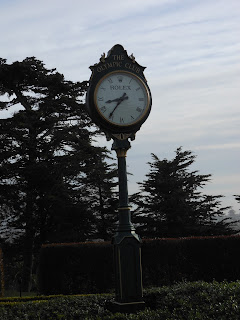 |
| Clock located next to the putting green. |
 |
| The Pro Shop at Olympic Club. |
 |
| The bench located next to the first tee box. |
- Holes 3 and 7 are listed as two of the top 500 holes in the world.
- Hole 18 is listed as one of the 18 hardest-to-putt greens in the world.
- Hole 18 is listed as one of the 18 holes that have produced the greatest moments in golf history when Jack Fleck scored a closing birdie and tied Ben Hogan's total for the 1955 U.S. Open, then beat Hogan in an eighteen-hole playoff.
The Olympic Club has hosted numerous championships including the Tour Championship in 1993 and 1994, the U.S. Amateur in 1958, 1981, and 2007, and the U.S. Open in 1955, 1966, 1987, 1998, and 2012. It also served as host to the inaugural U.S. Amateur Four-Ball Championship a month after our round. There is exactly one fairway bunker on the course, no water hazards, and yet it's one of the great tests of golf.
 |
| The Clubhouse at Olympic Club. |
 |
| The famous logo trimmed into the shrubbery. |
There are four sets of tees on the Lakes Course. From back to front, these are Black (74.7/138), Blue (73.5/133), White (72.2/128), and Green (68.6/122). At the suggestion of the member, we decided to play white tees on this day (and which all distances written about below will be from). A fair number of hole descriptions are offered by Chris Stein, the head golf professional at Olympic Club.
 |
| The flag used on each hole at Olympic Club. |
You start the round with a par 5 that measures out to 500 yards. It is reachable in two if you take the path of least resistance. This path includes a fade on the tee shot and a second shot that will be a downhill approach to the small green. We didn't have any noticeable wind this day, but the member advised the wind usually blows left to right on your second and third shots. The two fairway bunkers are positioned about 50 yards short of the green. If you need to lay up, make sure you have the correct yardage so you stay short of the fairway bunkers. You definitely should feel good with a par or better on this opening hole. Tom Watson made bogeys on the final two days of the 1987 U.S. Open.
 |
| A look down the fairway from the 1st tee box. |
 |
| A look into the 1st green from 100 yards out. |
 |
| A closer look at the 1st green. |
Hole two is a par 4 that plays to 367 yards. A 3-wood off the tee is the better play for a longer hitter. The rest of us can feel safe hitting a driver here. The target is the left green-side bunker with either a straight or slight fade shot off the tee. The second shot is uphill, so you may need to take an extra club. Try and keep your second shot left of the hole, which will give you an uphill putt as the green slopes drastically from right to left.
 |
| A look down the fairway from the 2nd tee box. |
 |
| A look into the 2nd green from 100 yards out. |
 |
| A closer look at the 2nd green. |
The par 3, third hole plays to 198 yards. Anywhere on this green is a good shot. You may not feel the wind on the tee, but as you hit your tee shot and the ball gets above the trees, the wind will tend to move the ball from left to right. Aiming toward the left side of the green is usually a good target. The green slopes front to back and is well bunkered on the left and right side.
 |
| A look onto the green from the 3rd tee box. |
 |
| A closer look at the 3rd green. |
The fourth hole is a 396 yard par 4. In order to hit this fairway, you will need to take a couple of things into consideration. A 3-wood or long iron off the tee is a smarter play. A driver may put you through the fairway with no shot to the green. The ideal tee shot would be a slight draw to hold the left-to-right sloping fairway. You are left with an uphill second shot that requires one extra club. Try and keep your ball short right of any hole location on your second shot.
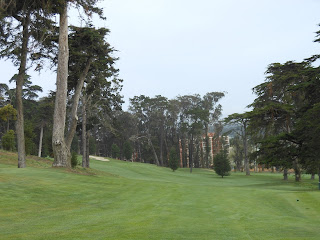 |
| A look down the fairway from the 4th tee box. |
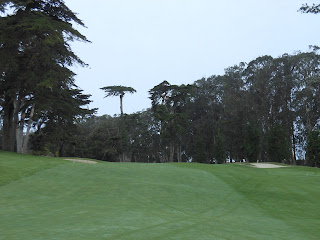 |
| A look towards the 4th green from 150 yards out. |
 |
| A large bunker protects the left side of the fairway, just short of the green. |
 |
| A closer look at the 4th green. |
The fifth hole is a 420 yard par 4. The target off the tee is to play left of the small flat-top tree with a fade. A 3-wood off the tee is a smart play for a longer hitter. The second shot may play a little shorter because it is slightly downhill and the wind is usually at your back when blowing. You will want to keep your ball short left of any hole location on this green.
 |
| A look down the fairway from the 5th tee box. |
 |
| A look into the 5th green from 80 yards out. |
The sixth hole is a 415 yard par 4. This is the first of the par-4 holes on the Lake Course where you can be aggressive with a driver. The only fairway bunker off the tee on the course, if you play to the right of it, you will have a medium- to short-iron shot into the green. The second shot will also play a little shorter as it is slightly downhill and usually downwind. There is a slight false front to the green. Try and keep your ball just short and left of most hole locations. If the hole location is front left, you may need to put your ball past the hole so you stay away from the false front.
 |
| A look down the fairway from the 6th tee box. |
 |
| A look into the 6th green from 170 yards out. |
 |
| A closer look at the 6th green. |
The seventh hole is the shortest par 4 on the course at 263 yards (294 from the tips) and is a risk-reward hole. A long hitter may try and reach the three-tiered green off the tee; the rest of us probably need to lay up with a 2- or 3-iron. If you try and reach the green, it is best to keep the ball slightly left or in the front bunkers. Any ball right of the green will be a difficult par. For those who lay up, ideally you would want a 70- to 90-yard shot into the green, which is an easier shot to put your ball on the correct level. If your ball is on the wrong level above the hole, you are looking at a good chance of a three-putt.
 |
| A look down the fairway from the 7th tee box. |
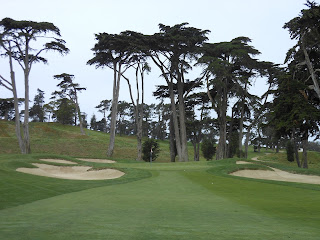 |
| A look into the 7th green from 80 yards out. |
The par 3, 154 yard 8th hole was redesigned six years ago. This hole is one of the toughest par 3s on the course despite its relatively short length. It is an uphill tee shot that is well guarded by cypress trees and two deep bunkers in the front left and right of the green. One of the longer greens on the course, it slopes back to front and has a false front that may cause your ball to roll off the green and down 20 to 30 yards short of the green.
 |
| A look into the green from the 8th tee box. |
The 382 yard, par 4 ninth hole is a downhill tee shot to the right-to-left sloping fairway and requires a fade off the tee with either a driver or 3-wood to keep the ball in the fairway. From there, you are faced with a slight side-hill lie with a mid to short iron. Your second shot must be short left of the hole in order to have a straight uphill putt.
 |
| A look down the fairway from the 9th tee box. |
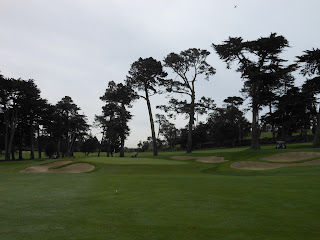 |
| A look into the 9th green from 100 yards out. |
This dogleg-left par 4 plays to 385 yards. Aiming a driver down the left side of the fairway with a slight fade is an ideal tee shot as the fairway slopes left to right. You have more room left than you think off this tee. Your second shot will be with a middle to short iron, and this green tends to run away from you, so play your second shot to land on the front part of this green. Once you’re on the green, it is a fairly flat putting surface.
 |
| A look down the fairway from the 10th tee box. |
 |
| A look into the 10th green from 120 yards out. |
After the 10th hole, I was treated to the famous Olympic Club burger dog pictured below. You can read more about the history of the burger dog at this
feature article. It was a fantastic fuel up for the back nine and was incredibly tasty.
 |
| The famous Olympic Burger Dog! |
The eleventh hole is a straightaway par 4 that plays 384 yards into a prevailing wind and will require a driver off the tee. A medium- to long-iron second shot to a two-tiered green is one of the toughest second shots on the course. Your second shot should be just short right of any hole location located left side of the green and short left if the hole location is located on the right side of the green.
 |
| A look down the fairway from the 11th tee box. |
 |
| A look into the 11th green from 150 yards out. |
The twelfth hole is a 375 yard par 4. This tee shot has a very narrow opening as the tall Monterey pine and cypress trees hover 100 yards off the tee. This hole was lengthened about 35 yards during the last renovation and now is one of the more difficult holes on the incoming nine. The tee shot should be directed at the left rough line with a slight fade. You will be left with a middle- to long-iron second shot into a very small green. This green has a fairly flat putting surface.
 |
| A look down the fairway from the 12th tee box. |
 |
| A look into the 12th green from 80 yards out. |
The thirteenth hole is a par 3 that plays 172 yards. It usually plays downwind and is guarded by two deep bunkers in front and left of the green. Playing a tee shot to land just over the front bunker will enable the ball to hold this green. Any shot short left of the hole will leave you with an uphill putt.
 |
| A look into the green from the 13th tee box. |
 |
| A closer look at the 13th green from the side. |
The fourteenth hole is a dogleg-left, par 4 that plays 388 yards and will require you to play your tee shot to the right side of the fairway to have a clear shot to the green. Playing down the left side of the fairway will leave you a shorter second shot to the green but you are bringing trouble into play. Keeping your ball short of the hole on this green will leave you with an uphill putt.
 |
| A look down the fairway from the 14th tee box. |
 |
| A look into the 14th green from about 130 yards out. |
The fifteenth hole is a 133 yard par 3 that requires an accurate tee shot to a well-bunkered green. The wind will usually blow from the players’ right to left, so aim your tee shot to the right side of the green. Missing this green leaves a difficult up-and-down. Any shot short of the hole will leave you an uphill putt as the green slopes back to front.
 |
| A look into the green from the 15th tee box. |
 |
| A side view of the 15th green.. |
 |
| A closer look at the 15th green. |
This 562-yard par 5 is a gradual dogleg left that will require a draw off the tee. Any drive hit straight or slightly right will go through the fairway. Since this hole is not reachable in two,you may want to hit a 3-wood off the tee to make sure you hit the fairway. Any ball hit into the rough off the tee will make hitting this green in regulation difficult. Your second shot should be aimed toward the right side of the fairway, so it opens up your third shot to the green. This green is fairly flat and is sloped back to front.
 |
| A look down the fairway from the 16th tee box. |
 |
| A look around the corner of the dogleg. |
 |
| A look into the 16th green from 120 yards out. |
This 464-yard par 5 will be reachable in two for the longest hitters. The tee shot should be placed on the left side of the fairway as the steep slope from left to right will move the ball to the right side of the fairway. The second shot will be either be a layup shot, which you will need to stay short left of the fairway bunker, or hitting a fairway wood or long iron into a very small elevated green that is well surrounded by deep bunkers. This green severely slopes from the back left to the front right and it is extremely important to keep your ball short right of any hole location. Any second shot that is hit right of the right bunkers will be nearly impossible to get up and down. A 4 on this hole is a very good score.
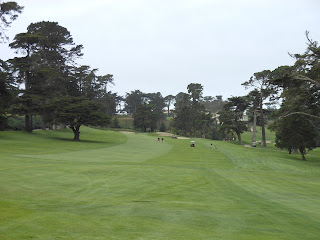 |
| A look down the fairway from the 17th tee box. |
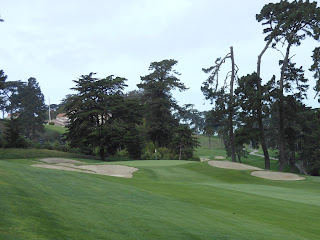 |
| A look into the 17th green from 100 yards out. |
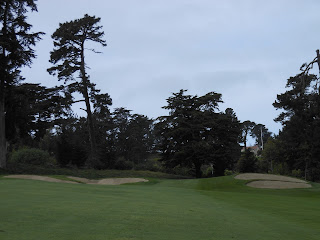 |
| A different look into the 17th green. |
The 322 yard par 4 eighteenth is one of the greatest short holes in golf. With the Clubhouse and Amphitheater in the background, this hole makes for a great finish.
A 3-wood or long iron is the play off this tee. The target off the tee is the left green-side bunker and let the wind move your tee shot to the middle of the fairway. A short iron to this uphill green must be kept below the hole. A forward tee will be used at some point during the championship, which will allow the players to go for the green; it will require a player to carry the ball 270 yards to reach the front edge of the green. A great risk-reward shot for this great finishing hole. Four bunkers surround the smallest green on the course.
 |
| A look down the fairway from the 18th tee box. |
 |
| A look into the 18th green from 175 yards out. |
 |
| A look back down the 18th hole from behind the green. |
After the round, Tom and I received a welcome surprise. We were planning to have lunch in the club house following the round. However, our member host advised there was a seldom used par 3 course, The Cliffs Course, located on the property and it had amazing views of the Pacific Ocean. He advised he had to leave but we were welcome to enjoy the Par 3 course for as long as we liked - We did! After some amazing short holes of golf, we found our way back to the club house for an amazing lunch.
I can't thank Tom and the member host enough for the invitation and the memories made at Olympic Club. I hope that our paths may cross again sometime in the future so we can enjoy another round together.

